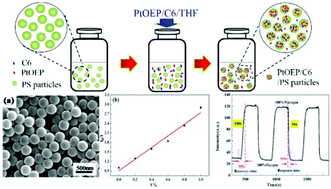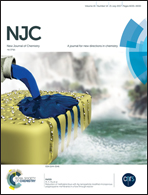High-performance dissolved oxygen sensors based on platinum(ii) porphyrin embedded in polystyrene beads†
Abstract
The preparation of polystyrene (PS) beads loaded with platinum octaethylporphyrin (PtOEP) via a swelling method has been well incorporated into dissolved oxygen (DO) sensing detection. The experimental results showed that the highest value of I0/I100 was 7.26 and the loading ratio of PtOEP was 51.33%; the luminescent intensity declined by only 2.23% under UV light for 1 hour. The response and recovery times were 16 s and 180 s, respectively. The peak position and intensity of the emission spectrum in buffer solutions with different pH values did not change. This indicates that this oxygen sensor has excellent sensitivity, light stability, reversibility, and pH resistance. Moreover, on this basis, we incorporated another oxygen insensitive dye, coumarin 6 (C6), to prepare a ratiometric oxygen sensor, which showed high sensitivity towards O2 with superior quenching efficiency. Finally, this oxygen sensor was used to monitor the content of DO in fish tank, tap water, and the Songhua River. All the measured results were well within the reference range.



 Please wait while we load your content...
Please wait while we load your content...